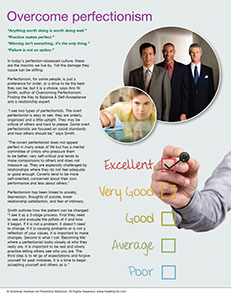SYMPTOM CHECKER
CONDITIONS
Male
Female
Child
Arm, Hand & Shoulder Concerns
Legs & Feet Concerns
Dental & Mouth Concerns
Ear & Nose
Eye Conditions
Head Conditions
Arm, Hand & Shoulder Concerns
Legs & Feet Concerns
Front
Back
Arm, Hand & Shoulder Concerns
Dental & Mouth Concerns
Ear & Nose
Eye Conditions
Head Conditions
Arm, Hand & Shoulder Concerns
Dental & Mouth Concerns
Ear & Nose
Eye Conditions
Head Conditions
Front
Back
Arm, Hand & Shoulder Concerns
Neck Links
Head & Neck Concerns
Arm, Hand & Shoulder Concerns
Neck Links
Head & Neck Concerns
Front
Back
Online Clinic
Wise Healthcare
Overcome perfectionism

Print on Demand
“Anything worth doing is worth doing well.”
“Practice makes perfect.”
“Winning isn’t everything, it’s the only thing.”
“Failure is not an option.”
In today’s perfection-obsessed culture, these are the maxims we live by. Yet the damage they cause can be stifling.
Perfectionism, for some people, is just a preference for order, or a drive to be the best they can be, but it is a choice, says Ann W. Smith, author of Overcoming Perfectionism: Finding the Key to Balance & Self-Acceptance and a relationship expert.
“I see two types of perfectionists. The overt perfectionist is easy to see, they are orderly, organized and a little uptight. They may be critical of others and hard to please. Some overt perfectionists are focused on social standards and how others should be,” says Smith.
“The covert perfectionist does not appear perfect in many areas of life but has a mental committee of critics who pressure them to be better; very self-critical and tends to make comparisons to others and does not measure up. They are especially challenged by relationships where they do not feel adequate or good enough. Coverts tend to be more self-oriented, concerned about their own performance and less about others.”
Perfectionism has been linked to anxiety, depression, thoughts of suicide, lower relationship satisfaction, and fear of intimacy.
Smith outlines how the pattern can be changed: “I see it as a 3-stage process. First they need to see and evaluate the pitfalls of it and how it began. If it is not a problem, it doesn’t need to change. If it is causing problems or is not a reflection of your values, it is important to make changes. Second is what I call ‘Becoming Me’ where a perfectionist looks closely at who they really are. It is important to be real and slowly practice letting others see who you are. The third step is to let go of expectations and forgive yourself for past mistakes. It is a time to begin accepting yourself and others as is.”
This website is not meant to substitute for expert medical advice or treatment. Follow your doctor’s or health care provider’s advice if it differs from what is given in this guide.
The American Institute for Preventive Medicine (AIPM) is not responsible for the availability or content of external sites, nor does AIPM endorse them. Also, it is the responsibility of the user to examine the copyright and licensing restrictions of external pages and to secure all necessary permission.
The content on this website is proprietary. You may not modify, copy, reproduce, republish, upload, post, transmit, or distribute, in any manner, the material on the website without the written permission of AIPM.
2021 © American Institute for Preventive Medicine - All Rights Reserved. Disclaimer | www.HealthyLife.com















































